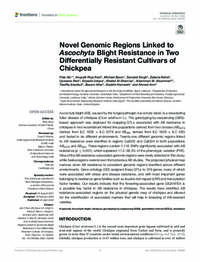Novel Genomic Regions Linked to Ascochyta Blight Resistance in Two Differentially Resistant Cultivars of Chickpea

Authors:
Ascochyta blight (AB), caused by the fungal pathogen Ascochyta rabiei, is a devastating foliar disease of chickpea (Cicer arietinum L.). The genotyping-by-sequencing (GBS)-based approach was deployed for mapping QTLs associated with AB resistance in chickpea in two recombinant inbred line populations derived from two crosses (AB3279 derived from ILC 1929 × ILC 3279 and AB482 derived from ILC 1929 × ILC 482) and tested in six different environments. Twenty-one different genomic regions linked to AB resistance were identified in regions CalG02 and CalG04 in both populations AB3279 and AB482. These regions contain 1,118 SNPs significantly associated with AB resistance (p ≤ 0.001), which explained 11.2–39.3% of the phenotypic variation (PVE). Nine of the AB resistance-associated genomic regions were newly detected in this study, while twelve regions were known from previous AB studies. The proposed physical map narrows down AB resistance to consistent genomic regions identified across different environments. Gene ontology (GO) assigned these QTLs to 319 genes, many of which were associated with stress and disease resistance, and with most important genes belonging to resistance gene families such as leucine-rich repeat (LRR) and transcription factor families. Our results indicate that the flowering-associated gene GIGANTEA is a possible key factor in AB resistance in chickpea. The results have identified AB resistance-associated regions on the physical genetic map of chickpea and allowed for the identification of associated markers that will help in breeding of AB-resistant varieties.
